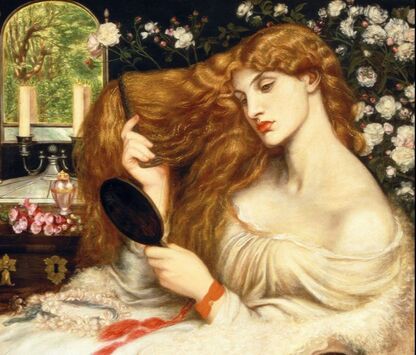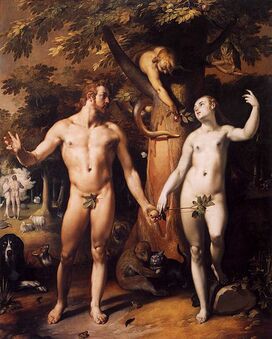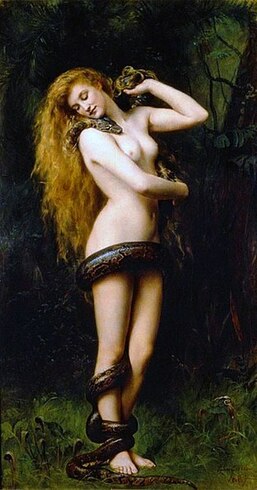|
By Ana Vice Once considered a prowling succubus, Lilith has evolved and coalesced into the goddess we know today, and has since become a symbol of freedom, independence, and feminine empowerment.  "Lady Lilith," by Gabriel Charles Dante Rossetti, 1882. "Lady Lilith," by Gabriel Charles Dante Rossetti, 1882. Seen both as so-called “bad girl” and a she-demon, Lilith is not only portrayed as the Serpent in the Garden of Eden and the first woman, but is at the origin of all desire and primal nature for humans. Her rites are of pain, sex, love, contravention, and transcendence. As an archetype, Lilith is continuously unfolding, inspiring us to recognize our fears and desires in order to transform them into armaments of power and as sources of and for healing – only if we are able to honor her within us. But this begs the question: Have we misunderstood all that Lilith is and if so, are we ready to understand now? Lilith has reached status as a dark goddess symbolizing lust, sensuality and carnal desire. She also characterizes all things “taboo” or “wicked.” A common myth is that Lilith was Adam’s first wife. Both Adam and Lilith were created from the clay of the Earth, but unlike Eve, Lilith was not created from Adam’s rib, and therefore could be considered an equal to Adam. But Adam did not like that Lilith refused to submissively lie beneath him during sexual intercourse, and so she became enraged and left the Garden of Eden. Despite attempts to bring her back, Lilith would not return. Eve was then created to be Adam’s companion, a figure often portrayed as an obedient, naive, and somewhat demure figure. Lilith, by contrast, represents everything uninhibited, uncontrolled, sexual, and disobedient. She’s impossible to domesticate with a will of her own. Because of her insubordination, she was exiled from Heaven and became transformed – a myth very similar to the story of Medusa in Greek mythology. Like Medusa, Lilith was wounded with injustice and became a dark creature: a demon, witch, vampire, and seductress.  "The Fall of Man," by Cornelis van Haarlem, 1592. "The Fall of Man," by Cornelis van Haarlem, 1592. Lilith has been depicted in art, media and literature throughout Western history. During the Renaissance period, Michelangelo portrayed her as a combined woman and serpent being for the Sistine Chapel (1508-1515) depicting her body coiled around the Tree of Knowledge. Later, Dante Gabriel Rossetti, a Pre-Raphaelite and Romanticist painter depicted her in his sensual artwork entitled Lady Lilith (1866-1868). In the 20th century, C.S. Lewis included a character in his The Chronicles of Narnia called the White Witch. She is described as an alluring, cunning, and cold-hearted daughter of Lilith determined to destroy the daughters and sons of Adam and Eve. In 1994, German-American artist Kiki Smith created a provocative modern sculpture of a crouching Lilith which is now part of SF MOMA. Currently, Lilith has resurfaced again in a prominent role for the new TV series, The Chilling Adventures of Sabrina. Digging a little deeper, Lilith has more than one origin myth and many guises. She is most often has been portrayed as a long-haired demon seductress who visits young men in the middle of the night to feed off their sexual arousal in a succubus fashion. This origin is in keeping with the stories of the ilû or lilitu, heralding back to ancient Babylonian and Mesopotamian sources. She appears as far back as The Epic of Gilgamesh and in the ancient Sumerian myth The Huluppu Tree.  "Lilith," by John Collier, 1892. "Lilith," by John Collier, 1892. In the Jewish tradition, she is included in the medieval text The Alphabet of Ben Sira. Some even believe she harms pregnant women and drinks the blood of newborn babies. This view has similarity to the tragic Greco-Roman story of Lamia who was transformed into a bloodlusting demon when Hera took her children after a tryst with Zeus. Interestingly, Lilith is not only associated with dark desires but also protection. Again, in Judaism, incantation bowls were sometimes buried upside down in cemeteries or houses in order to protect the home by trapping demons. On these “demon trapping bowls,” Lilith’s resemblance was painted along with protective spells. Some of these incantation bowls have been found and date back all the way to the Sassanid Empire (Babylon, 4th to 6th centuries CE). Lilith also epitomizes the sexuality and feminine sensuality that women (including transgenders or anyone who identifies with the divine feminine) are often told to hide or keep hidden in our patriarchal society. She symbolizes the lust deep within feminine sensuality. In Astrology, Lilith has important symbolic significance. Because Lilith is considered a “dark” goddess, darker associations prevail (e.g. pain, dark desires or sometimes negative emotions) in a person whose chart being worked on. For example, Lilith can represent a toxic relationship filled with misunderstanding and sometimes disrespect at its center. Graphically, the symbol used for Lilith has a crescent with a cross which can symbolize both mind and matter.  Carl Jung mentioned that Lilith was a “shamanistic anima” that could aid the repressed feminine to attain understanding and wisdom. This can be associated with Black Moon Lilith. Understanding and interpreting Black Moon Lilith in an astrological birth chart can bring information to the surface related to the shadow side of an individual. Black Moon Lilith is radical and accepting of what no longer serves us, allowing any untruths to be cast away until all that remains is the wild primal self.
2 Comments
2/21/2020 05:19:40 am
great quotes & wishes for mom!!! I love to share it with my mom on this mothers day Thanks a lot
Reply
S S
11/29/2021 07:55:36 am
I identify with Lilith after after being abused by men. She is a symbol of strength and empowers me to stand up for myself
Reply
Leave a Reply. |
Archives
April 2024
MastheadPublisher Categories |
 RSS Feed
RSS Feed